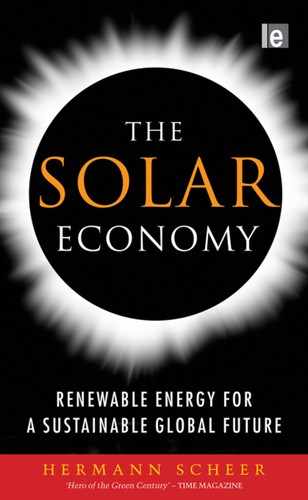0%
27Chapters
0-1Hours read
0kTotal Words
Book Description
The global economy and our way of life are based on the exploitation of fossil fuels, which not only threaten massive environmental and social disruption through global warming but, at present rates of consumption, will run out within decades, causing huge industrial dislocation and economic collapse. Even before then, the conflicts it causes in the Middle East and elsewhere will be frighteningly exacerbated. The alternative exists: renewable energy from renewable sources - above all, solar. Substituting renewable for fossil resources will take a new industrial revolution to avert the worst of the damage and establish a new international order. It can be done, and it can be done in time. The Solar Economy, by one of the world's most effective analysts and advocates, lays out the blueprints, showing how the political, economic and technological challenges can be met using indigenous, renewable and universally available resources, and the enormous opportunities and benefits that will flow from doing so.Table of Contents
- Front cover
- Title Page
- Copyright
- Contents
- Figures
- Foreword
- Acknowledgements
- Abbreviations
- Scenario From fossil fuels to solar power: transforming the global economy
- The power of the pyromaniacs
- Fossil resource dependency: how economic processes have come adrift from their environmental and social bases
- Global competition in place of global environmental policy
- The origins of the fossil-fuel economy
- Accelerating change and global displacement
- Business unbound: cutting loose from nature and society
- Reconnecting business and society through solar resources
- From the political to the economic solar manifesto
- PART I CAPTIVITY OR LIBERATION: FOSSIL FUEL AND SOLAR SUPPLY CHAINS COMPARED
- Chapter 1 Ensnared by fossil supply chains
- Long supply chains due to limited resources: the logic of globalization
- Fossil resource supply chains and industrial concentration: market destruction through market mechanisms
- The spider in the web: the growing influence of Big Energy and Big Mining
- The convergence of power: networking, supercartels and the disempowerment of democratic institutions
- Chapter 2 Exploiting solar resources: the new political and economic freedom
- Chapter 1 Ensnared by fossil supply chains
- PART II THE PATHOLOGICAL POLITICS OF FOSSIL RESOURCES
- PART III THROWING OFF THE FOSSIL SUPPLY CHAINS
- PART IV TOWARDS A SOLAR ECONOMY
- Chapter 9 Exploiting solar energy
- The role of capital allowances – and their problems
- Tax-exempt status for solar resources: overcoming the legitimacy crisis of environmental taxation
- Possibilities and problems in the market for green electricity
- Green suppliers and municipal self-sufficiency
- Creative destruction in the energy industry and the transformation of the resource industry
- Hard roads to soft resources
- Chapter 10 Regionalization of the global economy through solar resources
- Chapter 11 The visible hand of the sun: blueprint for a solar world
- Chapter 9 Exploiting solar energy
- References
- Index
